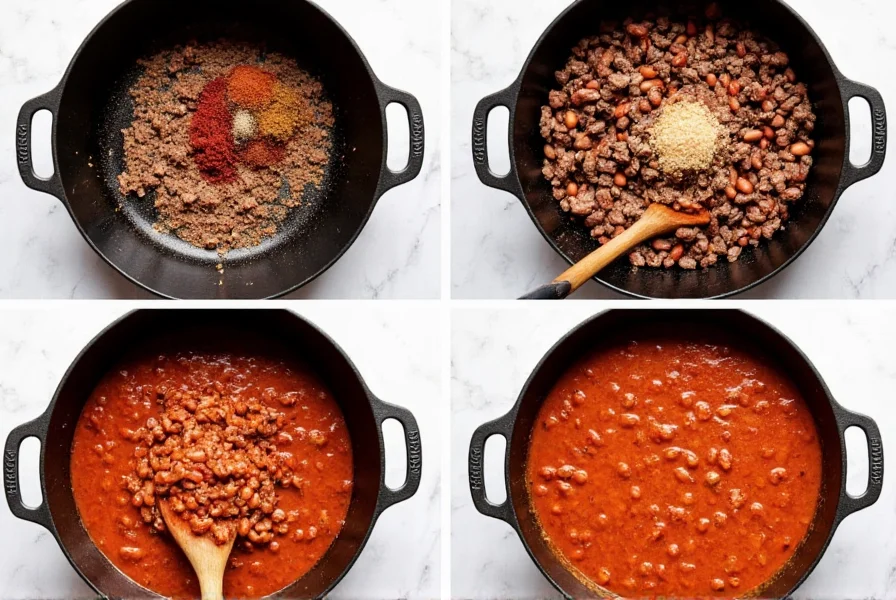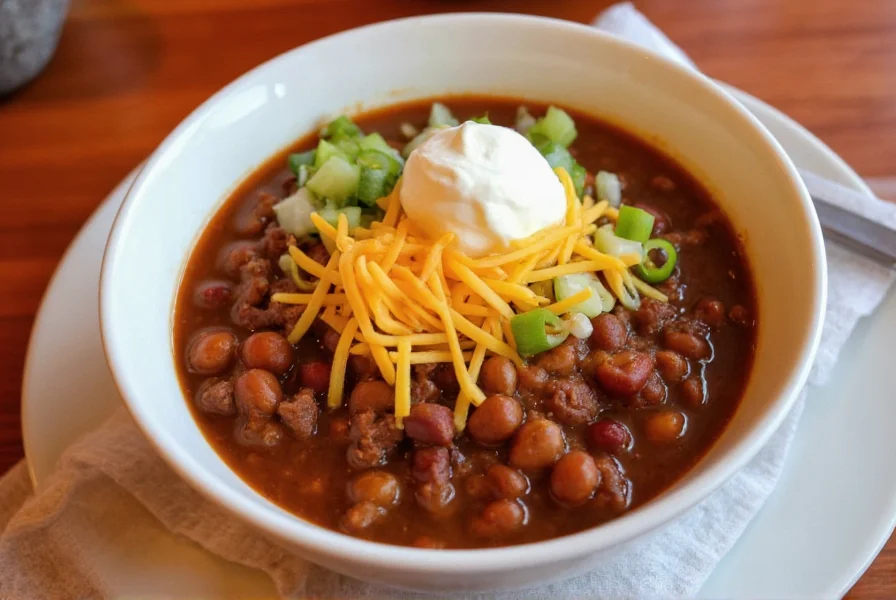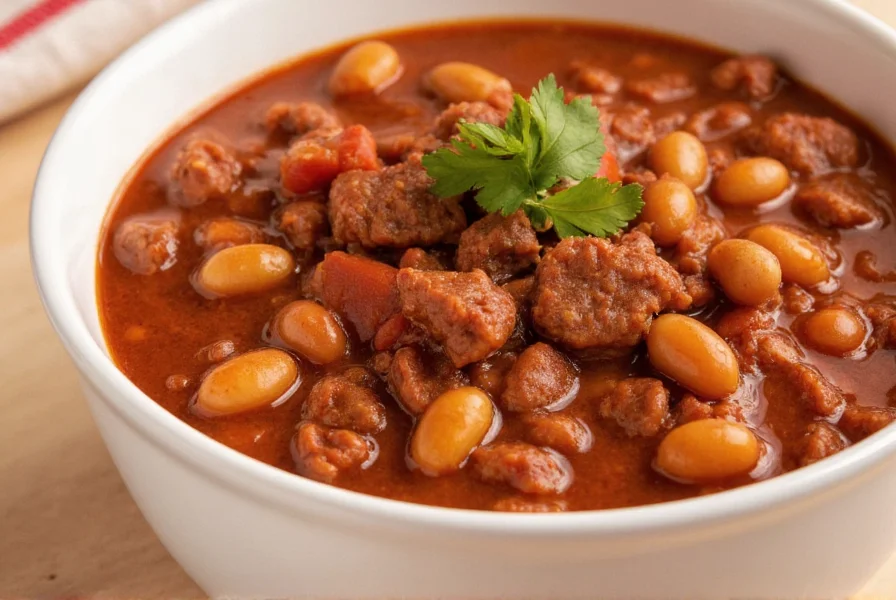The Essential Components of Perfect Beef and Bean Chili
Creating exceptional beef and bean chili requires understanding its foundational elements. Unlike Texas-style chili which omits beans, this popular variation incorporates kidney beans for texture and nutritional balance. The magic happens when quality beef browns properly, releasing fond that builds the flavor base. Best beef and bean chili recipe developers emphasize using a combination of fresh aromatics (onions, garlic) with dried spices for layered complexity.
Key Ingredients and Their Roles
Understanding each component's purpose transforms good chili into great:
| Ingredient | Function | Recommended Quantity |
|---|---|---|
| Ground chuck (80/20) | Rich flavor and fat for spice blooming | 1.5 lbs per 6 servings |
| Dark kidney beans | Texture contrast and protein | 2 cans (15oz each), drained |
| Fire-roasted tomatoes | Acidity and depth | 1 can (28oz) |
| Chili powder blend | Signature flavor base | 3-4 tbsp |
| Beef broth | Moisture without diluting flavor | 1.5 cups |
Step-by-Step Preparation Guide
Follow this how to make traditional beef chili with beans method for foolproof results:
- Brown the beef properly: Heat oil in heavy pot over medium-high. Add beef in single layer, breaking only after it releases from bottom. Remove when 75% browned.
- Build flavor foundation: Sauté onions until translucent, add garlic and spices, cooking 1 minute until fragrant.
- Combine and simmer: Return beef to pot with tomatoes, beans, and broth. Bring to gentle simmer.
- Low and slow cooking: Reduce heat to low, cover partially, and cook 60-90 minutes, stirring occasionally.
- Final seasoning: Adjust salt, add splash of vinegar or lime juice to brighten flavors before serving.

Avoiding Common Chili Mistakes
Even easy weeknight beef and bean chili can go wrong without proper technique:
- Overcrowding the pot: Causes steaming instead of browning - work in batches
- Adding cold liquids to hot pot: Stops the cooking process - warm broth before adding
- Underseasoning: Spices need time to mellow - season in layers
- Skipping the bloom: Toasting spices in oil unlocks flavor compounds
- Overcooking beans: Add canned beans late to maintain texture
Variations for Different Preferences
Adapt this versatile dish to suit any palate:
Slow Cooker Method
For slow cooker beef and bean chili, brown meat first, then transfer to crockpot with all ingredients. Cook on low 6-8 hours. The extended time develops deeper flavors while maintaining bean integrity.
Spice Level Adjustments
Control heat with these techniques:
- Mild: Omit fresh peppers, use sweet paprika
- Medium: Add 1 diced jalapeño with seeds removed
- Hot: Include 1-2 chipotle peppers in adobo sauce
Dietary Modifications
Create a healthy beef and bean chili recipe by:
- Using lean ground sirloin and draining excess fat
- Adding extra vegetables like zucchini or bell peppers
- Reducing sodium with no-salt-added beans and broth
- Boosting fiber with black beans alongside kidney beans
Serving and Storage Recommendations
Maximize enjoyment with these professional tips:
- Resting time: Let chili sit 15 minutes off heat before serving for flavors to marry
- Traditional toppings: Sharp cheddar, sour cream, scallions, and oyster crackers
- Freezing: Store in airtight containers up to 3 months - flavors improve over time
- Reheating: Add splash of broth when warming to restore consistency

Nutritional Profile
A standard serving (1.5 cups) of traditional beef and bean chili provides:
- Approximately 320 calories
- 24g protein from combined beef and beans
- 12g fiber (40% daily value)
- Rich in iron, zinc, and B vitamins
- Naturally gluten-free when prepared carefully
Frequently Asked Questions
Can I make beef and bean chili without tomatoes?
Yes, you can substitute tomato products with roasted red peppers blended with broth for similar acidity and body. Many Southwestern variations use tomatillos instead of tomatoes for a brighter flavor profile.
How do I fix chili that's too spicy?
Add dairy (sour cream or shredded cheese), acid (lime juice), or sweetness (a teaspoon of honey). You can also dilute with additional beans and broth. Remember that spice perception decreases as the chili sits, so wait 15 minutes before making major adjustments.
What's the difference between chili con carne and beef and bean chili?
Traditional chili con carne ('chili with meat') from Texas often contains only meat, spices, and sometimes suet - no beans. Beef and bean chili is a regional variation that incorporates beans, which became popular as chili spread beyond Texas. Both can be authentic depending on regional preferences.
Can I use different beans in beef chili?
Absolutely. While kidney beans are traditional, many cooks combine pinto beans for creaminess or black beans for earthiness. For spicy beef chili with kidney beans, maintain at least 50% kidney beans to preserve the classic texture and appearance.
How long should I simmer chili for best flavor?
Minimum 45 minutes for flavors to blend, but 90 minutes produces significantly better results. The collagen in meat breaks down completely around 2 hours. For authentic Texas-style beef chili with beans, many chefs recommend 3-4 hours of gentle simmering for maximum flavor development.











 浙公网安备
33010002000092号
浙公网安备
33010002000092号 浙B2-20120091-4
浙B2-20120091-4